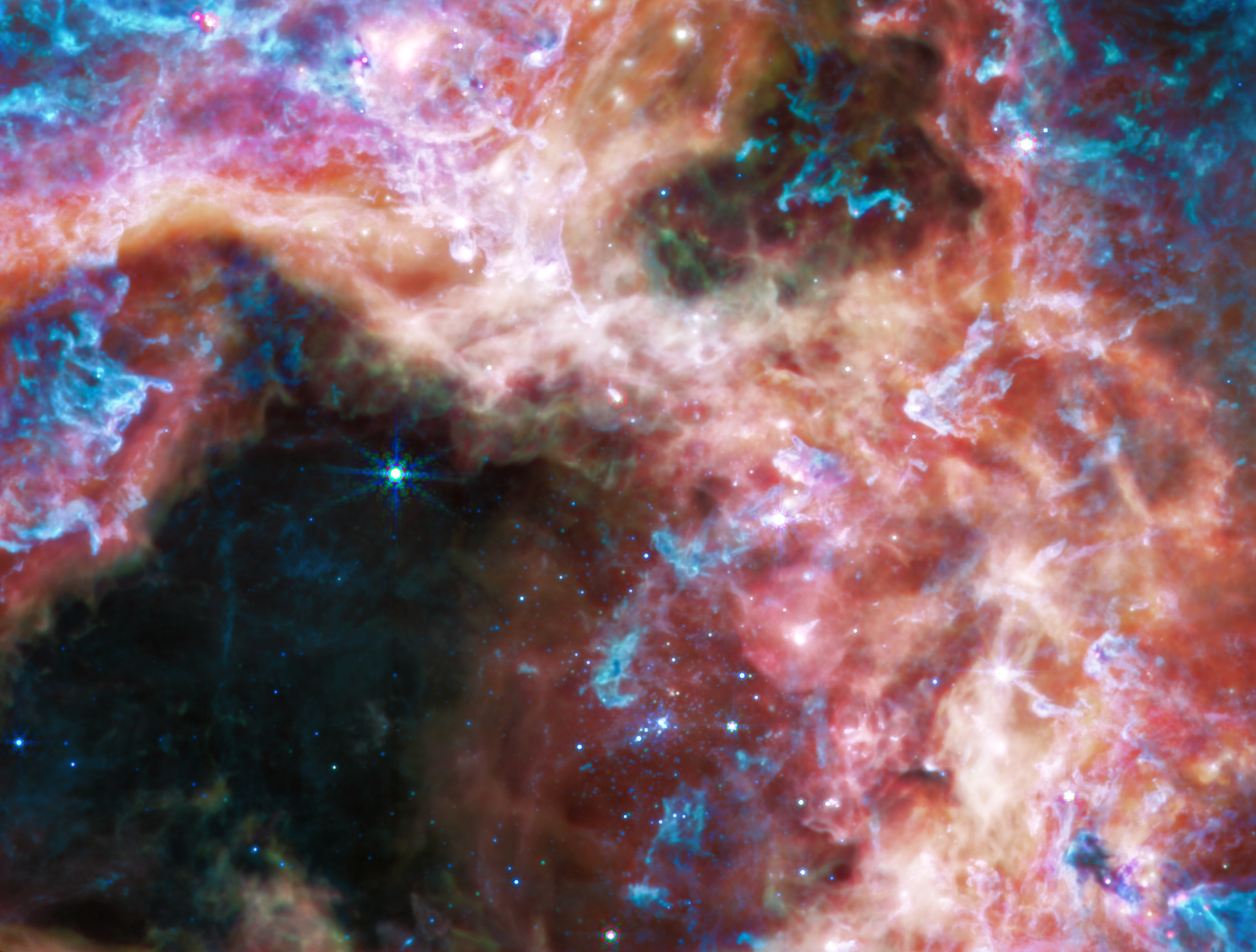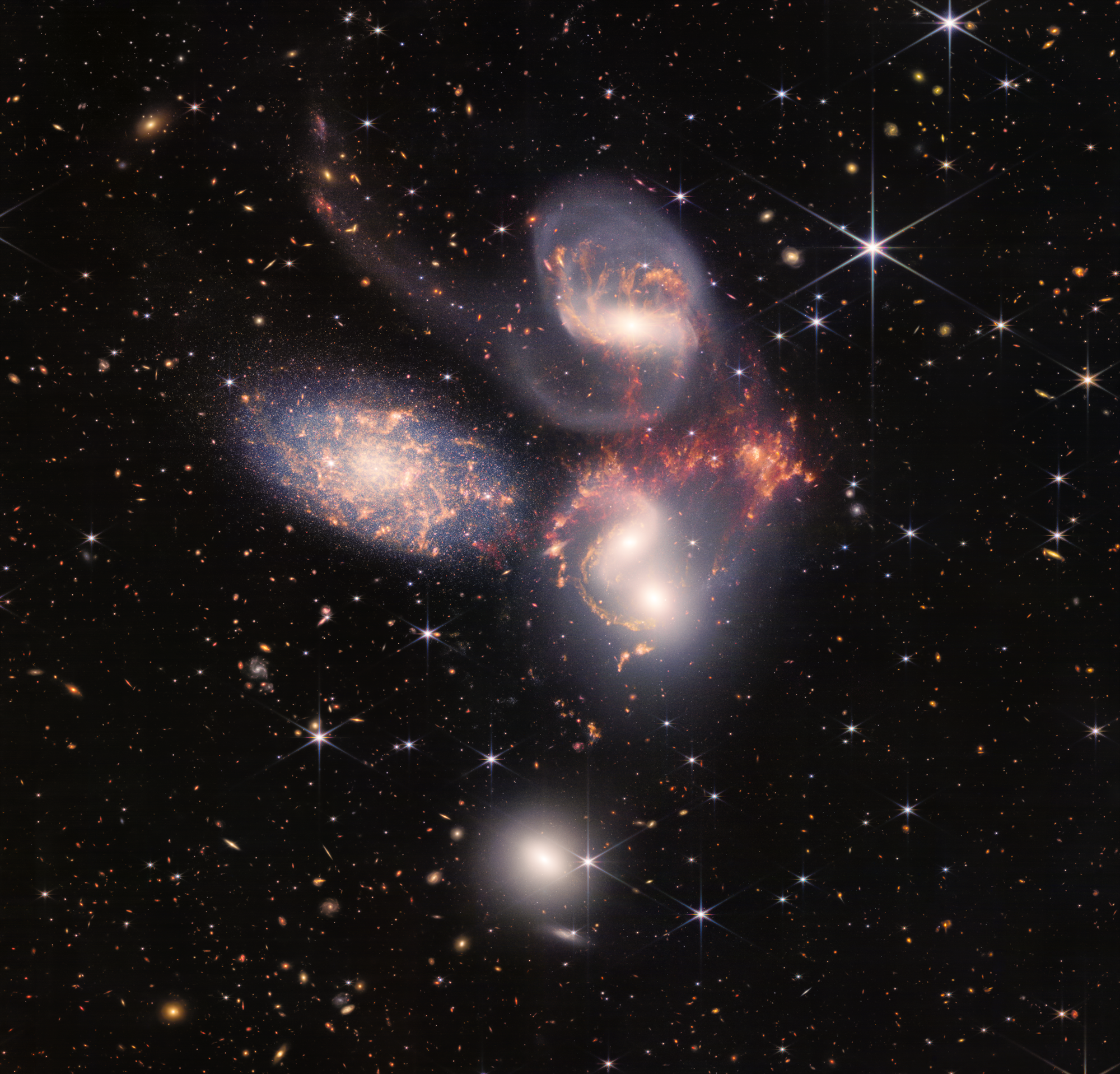1. Tarantula Nebula (NIRCam Image)
Exposure Dates:- 2 June 2022
Release Date:- September 06, 2022 10:00AM
All images are James Webb telescope In this mosaic image stretching 340 light-years across, Webb’s Near-Infrared Camera (NIRCam) displays the Tarantula Nebula star-forming region in a new light, including tens of thousands of never-before-seen young stars that were previously shrouded in cosmic dust. The most active area appears to sparkle with massive young stars, appearing pale blue. Scattered among them are still-embedded stars, appearing red, yet to emerge from the dusty cocoon of the nebula. NIRCam is able to detect these dust-enshrouded stars thanks to its unprecedented resolution at near-infrared wavelengths.https://webbtelescope.org/resource-gallery/images

Credits: IMAGE: NASA, ESA, CSA, STScI
- Object Name:- Tarantula Nebula, 30 Doradus, 30 Dor, NGC 2070
- Object Description:- Emission Nebula in the Large Magellanic Cloud
- R.A. Position:- 05:38:42.4
- Dec. Position:- -69:06:03.35
- Constellation:- Dorado
- Distance:- 170,000 light-years (52,000 parsecs)
- Dimensions:- Image is 7.24 arcmin across (about 360 light-years
2 Tarantula Nebula (MIRI Image)
Exposure Dates:- 10 June 2022
Release Date:- September 06, 2022 10:00AM
At the longer wavelengths of light captured by its Mid-Infrared Instrument (MIRI), Webb focuses on the area surrounding the central star cluster and unveils a very different view of the Tarantula Nebula. In this light, the young hot stars of the cluster fade in brilliance, and glowing gas and dust come forward. Abundant hydrocarbons light up the surfaces of the dust clouds, shown in blue and purple. Much of the nebula takes on a more ghostly, diffuse appearance because mid-infrared light is able to show more of what is happening deeper inside the clouds. Still-embedded protostars pop into view within their dusty cocoons, including a bright group at the very top edge of the image, left of center.

Credits: IMAGE: NASA, ESA, CSA, STScI
- Object Name:- Tarantula Nebula, 30 Doradus, 30 Dor, NGC 2070
- Object Description:- Emission Nebula in the Large Magellanic Cloud
- R.A. Position:- 05:38:42.4
- Dec. Position:- -69:06:03.35
- Constellation:- Dorado
- Distance:- 170,000 light-years (52,000 parsecs)
- Dimensions:- Image is 2.64 arcmin across (about 130 light-years)
3 Cartwheel Galaxy
Exposure Dates:- 10-11 June 2022
Release Date:- August 02, 2022 10:00AM
This image of the Cartwheel and its companion galaxies is a composite of Webb’s Near-Infrared Camera (NIRCam) and Mid-Infrared Instrument (MIRI), which reveals details that are difficult to see in the individual images alone.
This galaxy formed as the result of a high-speed collision that occurred about 400 million years ago. The Cartwheel is composed of two rings, a bright inner ring, and a colorful outer ring. Both rings expand outward from the center of the collision like shockwaves.

Credits: IMAGE: NASA, ESA, CSA, STScI
- Object Name:- Cartwheel Galaxy, ESO 350-40, AM0035-335
- Object Description:- Interacting Galaxies
- R.A. Position:- 00:37:41.09
- Dec. Position:- -33:42:59.0
- Constellation:- Sculptor
- Distance:- 500 million light-years (150 Mpc)
- Dimensions:- Image is 2.34 arcmin across (about 340,000 light-years)
4 “Cosmic Cliffs” in the Carina Nebula
Exposure Dates:- 3 June 2022
Release Date:- July 12, 2022 11:22AM
What looks much like craggy mountains on a moonlit evening is actually the edge of a nearby, young, star-forming region NGC 3324 in the Carina Nebula. Captured in infrared light by the Near-Infrared Camera (NIRCam) on NASA’s James Webb Space Telescope, this image reveals previously obscured areas of star birth.

Credits: IMAGE: NASA, ESA, CSA, STScI
Called the Cosmic Cliffs, the region is actually the edge of a gigantic, gaseous cavity within NGC 3324, roughly 7,600 light-years away. The cavernous area has been carved from the nebula by the intense ultraviolet radiation and stellar winds from extremely massive, hot, young stars located in the center of the bubble, above the area shown in this image. The high-energy radiation from these stars is sculpting the nebula’s wall by slowly eroding it away.
- Object Name:- Carina Nebula, NGC 3324
- Object Description:- Star-forming region in the Carina Nebula
- R.A. Position:- 10:36:59.0
- Dec. Position:- -58:37:0.0
- Constellation:- Carina
- Distance:- 7,600 lightyears away (2,300 parsecs)
- Dimensions:- Image is about 7.3 arcminutes across (16 light-years)
5 Stephan's Quintet
Exposure Dates:- NIRCam: 11 June 2022; MIRI: 11-12 June, 1 July 2022
Release Date:- July 12, 2022, 11:13 AM
An enormous mosaic of Stephan’s Quintet is the largest image to date from NASA’s James Webb Space Telescope, covering about one-fifth of the Moon’s diameter. It contains over 150 million pixels and is constructed from almost 1,000 separate image files. The visual grouping of five galaxies was captured by Webb’s Near-Infrared Camera (NIRCam) and Mid-Infrared Instrument (MIRI).

Credits: IMAGE: NASA, ESA, CSA, STScI
With its powerful, infrared vision and extremely high spatial resolution, Webb shows never-before-seen details in this galaxy group. Sparkling clusters of millions of young stars and starburst regions of fresh star birth grace the image. Sweeping tails of gas, dust, and stars are being pulled from several of the galaxies due to gravitational interactions. Most dramatically, Webb’s MIRI instrument captures huge shock waves as one of the galaxies, NGC 7318B, smashes through the cluster. These regions surrounding the central pair of galaxies are shown in the colors red and gold
- Object Name:- Stephan’s Quintet, Hickson Compact Group (HCG) 92, NGC 7318A, NGC 7318B, NGC 7319, NGC 7320
- Object Description:- Interacting Galaxy Group
- R.A. Position:- 22:35:57.49
- Dec. Position:- 33:57:36.0
- Constellation:- Pegasus
- Distance:- 290 million light-years (89 million parsecs)
- Dimensions:- Image is about 7.4 arcmin across (about 620,000 light-years)
6 Southern Ring Nebula (NIRCam and MIRI Images Side by Side)
Exposure Dates:- 3 June 2022, 12 June 2022
Release Date:- July 12, 2022, 11:01 AM
The bright star at the center of NGC 3132, while prominent when viewed by NASA’s Webb Telescope in near-infrared light, plays a supporting role in sculpting the surrounding nebula. A second star, barely visible at the lower left along one of the bright star’s diffraction spikes, is the nebula’s source. It has ejected at least eight layers of gas and dust over thousands of years.

Credits: IMAGE: NASA, ESA, CSA, STScI
But the bright central star visible here has helped “stir” the pot, changing the shape of this planetary nebula’s highly intricate rings by creating turbulence. The pair of stars are locked in a tight orbit, which leads the dimmer star to spray ejected material in a range of directions as they orbit one another, resulting in these jagged rings.
Hundreds of straight, brightly-lit lines pierce through the rings of gas and dust. These “spotlights” emanate from the bright star and stream through holes in the nebula like sunlight through gaps in a cloud. https://webbtelescope.org/news/first-images
- Object Name:- Southern Ring Nebula, NGC 3132, Eight-Burst Nebula
- Object Description:- Planetary Nebula
- R.A. Position:- 10:06:58.54
- Dec. Position:- -40:26:00
- Constellation:- Vela
- Distance:- 2,000 light-years (590 parsecs)
- Dimensions:- Image is about 2.4 arcmin across (1.4 light-years)
7 Webb's First Deep Field
Thousands of galaxies flood this near-infrared image of galaxy cluster SMACS 0723. High-resolution imaging from NASA’s James Webb Space Telescope combined with a natural effect known as gravitational lensing made this finely detailed image possible.

Credits: IMAGE: NASA, ESA, CSA, STScI
First, focus on the galaxies responsible for the lensing: the bright white elliptical galaxy at the center of the image and smaller white galaxies throughout the image. Bound together by gravity in a galaxy cluster, they bend the light from galaxies that appear in the vast distances behind them. The combined mass of the galaxies and dark matter act as a cosmic telescope, creating magnified, contorted, and sometimes mirrored images of individual galaxies.
- Object Name:- SMACS 0723-73 (1RXS J072319.7-732735, SMACS J0723.3-7327)
- Object Description:- Lensing Galaxy Cluster
- R.A. Position:- 07:23:19.5
- Dec. Position:- -73:27:15.6
- Constellation:- Volans
- Distance:- Redshift of the cluster is z=0.39 (about 4.24 billion light-years)
- Dimensions:- The image is about 2.4 arcmins across



Comments(0)